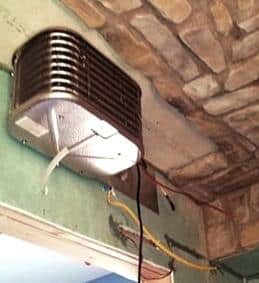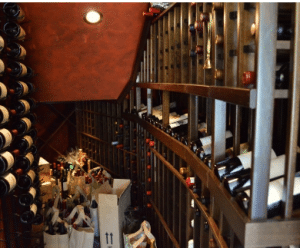The primary purpose of a wine cellar is to provide a secure and stable environment, conducive to storing and aging wines for a prolonged period of time. Custom wine rooms are properly insulated, sealed, and installed with wine cellar cooling systems, to ensure that the desired climate conditions for long-term storage are achieved and maintained.
Wine cellar refrigeration systems are a crucial component of actively cooled wine cellars. A wine cellar refrigerator is specially designed to help maintain the ideal wine cellar temperature and humidity levels for the proper preservation of wines. For wines to mature to their full potential, the temperature range must be at a constant 50°F to 55°F, while the relative humidity should stay between 60 to 75 percent.
There are three ways to cool a custom wine cellar: self-contained cooling systems, ductless split refrigeration systems, and ducted-split climate control systems. Each refrigeration unit has its own distinct features and advantages, but all are engineered to efficiently stabilize wine cellar temperature and humidity, and reliably cool a wine storage space.
Self-Contained Wine Cellar Refrigeration Systems
Self-contained wine cellar refrigeration systems are perfect for wine rooms up to 2,000 cubic feet in size. These cooling units are the easiest to install, and do not require assistance from a licensed HVAC/R technician. Aside from providing ease of installation, self-contained cooling systems are the most affordable refrigeration systems around.
A self-contained wine cellar refrigerator is mounted high on the wall, and vents fan noise and warm air into an adjoining room. The latter must be at least the same size or larger than the wine room itself. Additionally, the room must have proper ventilation, and must not exceed 80°F. If the cooling unit vents through a small, confined space, it will not function as effectively, and will most likely blow hot air into the wine cellar as a result.
These refrigeration units can be installed in an unused area between the entry door and the ceiling, or mounted within the racking frame. Most self-contained cooling products have a depth of 13 inches, so these units will fit snugly within the confines of the wine racking system.
Split Wine Cellar Cooling Systems (Ductless and Ducted Cooling Systems)
Split wine cellar cooling systems separate the evaporator unit from the condensing unit, which not only provides flexibility in installation, but also promotes efficient and silent cooling. Splitting them apart allows the noisiest component of the cooling unit (the condenser) to be placed in a remote location, while the evaporator is installed inside or near a wine room. There are two types of split systems: ductless split refrigeration systems and ducted-split climate control systems.
Ductless split wine cellar refrigeration systems use electrical wiring and small copper tubing to connect the condensing unit to the evaporator unit. Using a line set eliminates venting through an adjacent enclosure or the need for ductwork. For this particular split system, the evaporator is placed inside the wine room, while the condenser is installed in a location that is ideal for effective heat and noise dissipation (e.g. outdoors, the garage, etc.).
Ducted-split wine cellar cooling systems make use of ductwork to distribute cool air into the wine storage space, and to draw warm air outdoors through a return air duct. The cooling system evaporator is placed near the wine cellar or in another location indoors, while the condensing unit is located outdoors. Ducted-split systems eliminate the presence of refrigeration equipment inside wine cellars, thus providing more room for storage and preserving the aesthetic quality of the space.
In order for a wine cellar refrigerator to be efficient in its performance, it must be integrated into the overall wine cellar plans and design. After applying the proper insulation and vapor barrier, and completely sealing the wine room, the right type of wine cellar climate control system must be installed to reach the ideal wine cellar temperature and humidity levels for long-term wine storage.
There are important factors to consider when choosing the best cooling system for a wine cellar space. These factors are: ambient conditions, room size, frequency of door opening/closing, the location of the wine room, and the size of the wine collection.
When building a residential or commercial wine cellar, consulting with professional wine cellar builders is highly recommended. They are experts in designing and constructing a wine storage space that provides the best environment for storing and aging wines. Wine cellar builders will create wine cellar plans based on the design specifications and storage needs of their clients.
Most wine cellar builders not only design and execute wine cellar plans, but also install all wine room components, including wine racking solutions, flooring products, wine cellar doors, and climate control systems. With regard to wine cellar cooling systems, wine cellar builders conduct a heat load calculation to determine the proper cooling system, that will efficiently cool a wine storage space.



